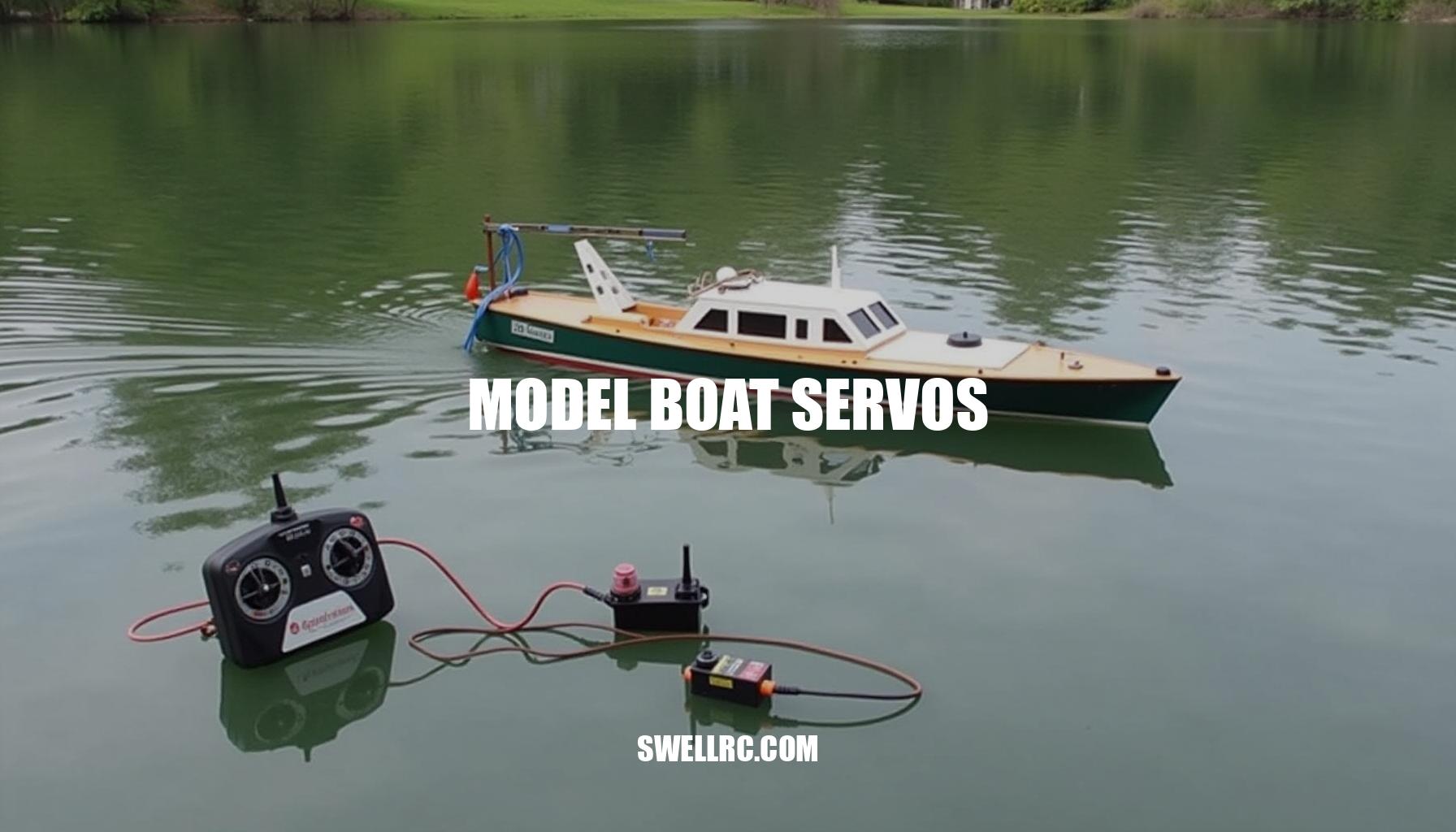Mastering Model Boat Servos: Expert Tips for Precision Control
The first time I watched a well-tuned model boat servo sweep smoothly at idle and snap precisely at speed, I finally “felt” what RC servos really do. After months of swapping servo brands, changing horn lengths, and pushing endpoints too far, I discovered the perfect balance: enough torque ratings to hold course in chop, servo speed for fast return-to-center, and waterproof servo reliability essential for marine environments. Understanding servo mechanics is crucial to mastering marine servo systems and achieving crisp control with your radio transmitter controls.
In this guide, I’ll share what actually matters—how servos work, how to choose torque and speed for your hull, what waterproofing and materials buy you, and exactly how to install and tune for precision response.
How Model Boat Servos Work — From Receiver to Rudder: The Tech That Brings Miniature Marine Control to Life
Understanding the servo signal flow is crucial for optimizing your RC boat’s performance. Your transmitter sends a signal to the receiver, which then outputs a control pulse to the servo. The servo’s PCB compares this pulse to its internal position, derived from a potentiometer or sensor, and drives the motor through gears to rotate the output shaft and arm.
On the water, this mechanism converts stick position into rudder angle or throttle/brake action.
| Aspect | Analog Servos | Digital Servos |
|---|---|---|
| Pulsing Frequency | Lower frequency | Higher frequency |
| Response under Load | Softer, less precise | Crisper and more precise |
| Holding Center | Less effective against water pressure | Better at maintaining center position |
When setting up your servo linkage, remember that servo arm alignment and properly configuring endpoints and sub-trim can make a significant difference. Correct adjustments reduced my oversteer and helped keep the hull tracking straighter in chop. Cross-application insight also proves valuable; servos designed for airframes can work excellently in boats if the torque, speed, and sealing meet the requirements.
For example, check out RC Airplane Servos and Micro Servos for RC Airplanes, which are especially handy for tight hulls and scale builds.
If you experience noisy servo operation such as jittering or buzzing, troubleshooting should include checks for radio interference, sticky linkages, or over-tightened pushrods causing constant correction. Ensuring the proper receiver to servo signal integrity and smooth mechanical connections will enhance your overall control and response.
How Servos Work: Torque and Speed Benchmarks (Quick Reference)
When selecting a marine servo system, understanding the various servo torque ranges and servo speed benchmarks is essential for optimal performance. Below is a table summarizing typical classes of servos used in marine applications, including their torque, speed, and typical use cases:
| Class | Typical Torque (kg·cm) | Speed (s/60°) | Use |
|---|---|---|---|
| Micro | 1.5–3.5 | 0.08–0.12 | Small scale boats, light rudders |
| Standard | 5–10 | 0.10–0.18 | Most sport hulls up to mid-size |
| High-torque standard | 10–20 | 0.10–0.16 | Heavier hulls, strong water load |
| Large/giant scale | 20–40+ | 0.12–0.20 | Big tugs, gas/nitro, twin-rudder setups |
Keep in mind that waterproof servo ratings and gear material composition play a crucial role in the digital servo holding power and overall durability to withstand spray and splash in marine environments. Investing in servos with robust waterproofing and hardened gears ensures longer service life and reliable operation under demanding conditions typical of watercraft applications.
Key Specs That Matter — Torque, Speed, and Strength: Decoding Servo Performance Metrics
Torque holds course; speed delivers feel. In testing across multiple hulls, I found a simple rule: size torque to worst-case water load (turns at speed and crosswind), then choose the fastest servo you can within budget that still offers waterproof servo design and metal gears. Metal vs plastic gears is a crucial consideration; metal or steel gears resist shock loads from high-speed rudder snaps, while plastic gears are lighter and quieter but can strip in heavy boats. When evaluating high-torque servos, servo durability often depends more on robust waterproofing (gaskets, o-rings, coated boards) than on brand hype.
My longest-lasting boat servos were those with a balanced combination of waterproof servo design and mid-high torque, rather than those claiming the fastest specs.
To help with servo selection criteria, here’s a quick comparison table:
| Feature | Metal Gears | Plastic Gears |
|---|---|---|
| Durability | High, better shock resistance | Moderate, prone to stripping in heavy boats |
| Weight | Heavier | Lighter |
| Noise Level | Louder | Quieter |
| Servo Durability | Superior especially with waterproof design | Less durable under heavy loads |
| Waterproof Servo Design Importance | Critical for longevity | Equally critical, but plastic gears are more vulnerable without sealing |
For a structured decision flow—while originally designed for RC planes—the logic transfers well to boats. Check out How to Choose Servos for RC Plane for a detailed guide that complements these high-torque servos and waterproof servo design considerations.
Torque vs. Boat Size (Practical Guidance)
When selecting servos for your model boats, understanding the boat size categories and matching them with appropriate servo specifications is crucial for confident water navigation. Below is a quick mapping of servo torque and speed requirements based on different boat sizes, serving as a practical guide for servo torque mapping:
| Boat Size Category | Torque (kg·cm) | Speed (s/60°) |
|---|---|---|
| Small Electric Scale Boats (< ~500 mm) | 2–5 | 0.10–0.12 |
| Sport Hulls (500–800 mm) | 6–10 | 0.10–0.16 |
| Heavy Scale/Tugs (700–1000 mm) | 10–20 | 0.12–0.16 |
| Large/Nitro/Gas or Twin Rudders | 20–35+ | 0.12–0.18 |
For optimal performance, consider digital servo holding torque and waterproof capabilities when spray is frequent, as these servos provide stronger holding power and enhanced durability. While analog servos are acceptable for calm-scale cruisers with less stress on centering, they often deliver softer centering compared to their digital counterparts. Making an informed servo speed selection aligned with your boat’s size and usage conditions ensures precise control and improves your overall boating experience on the water.
Installation and Setup — Getting Hands-On: How I Dialed in My Model Boat Servos for Perfect Precision
My best servo installation follows a simple rhythm: mock-up, mount, align, tune. To ensure optimal performance, follow these key steps:
- Dry-fit the servo so the output shaft aligns precisely with the rudder linkage path, ensuring proper linkage geometry.
- Isolate vibration using rubber grommets and secure with stainless hardware to promote waterproof mounting and durability.
- Power the receiver and electronically center the servo before attaching the servo horn at true neutral, crucial for accurate servo horn alignment.
- Adjust the endpoints in the transmitter so the rudder reaches mechanical limits only via the radio settings; avoid jamming the linkage by overtravel, a critical step in endpoint adjustment.
- Add a slight exponential on steering controls to provide smoother handling during low-speed docking maneuvers.
Common pitfalls to avoid include over-tight pushrods causing buzzing noises, the horn installed off-center, and using excessively long servo arms that amplify slop. These issues can negatively impact the precision of your throttle and rudder setup.
The same principles apply for throttle and outboard steer/tilt mechanisms. For detailed guidance, refer to resources like Model Outboard Motors for Model Boats and pairing motors with the correct control range found at RC Boat Motor.
Quick Servo Setup Checklist (Save-it-and-Sail)
Ensuring a smooth and reliable operation of your RC vehicle involves a meticulous servo setup checklist. Begin by electronically centering the servo before installing the horn, which guarantees precise control. Keep pushrods straight and well-supported to avoid any binding that can affect movement.
When selecting components during your servo linkage setup, choose metal gears for heavy hulls or high-load applications, while plastic gears suffice for lighter scale builds. Properly set endpoints and sub-trim settings, then confirm that there is no mechanical jamming to ensure optimal responsiveness.
Maintaining your equipment with waterproof servo maintenance is crucial, especially if operating in damp environments. Use gaskets and apply dielectric grease on plugs to prevent moisture ingress, and incorporate drip loops in wiring to further protect connections.
Don’t overlook performing a thorough radio range test before launch to verify that controls respond reliably over distance. Finally, after the initial run, re-tighten all hardware and re-check servo neutral positions to maintain consistent performance.
Advanced Applications — Pushing the Limits: High-Torque and Long-Range Servo Systems
Bigger hulls and rougher water demand more holding power and smarter control. High-torque servos are essential as they resist rudder blowback and keep trim tabs locked firmly at speed, ensuring your boat maintains precise handling in challenging conditions.
To achieve optimal performance, these digital servos need to be paired with a quality transmitter that offers refined transmitter endpoints and curve control. This combination enhances digital servo precision, allowing you to make subtle adjustments for smoother and more responsive steering.
For recommendations on the best transmitters to use with your setup, check out Best RC Transmitter for Boats.
When planning offshore-style runs or navigating expansive lakes, considering long-range RC systems is crucial. These systems focus on maximizing operational range while minimizing interference, which is vital for maintaining control over greater distances. For a comprehensive overview, see this explainer on long-range remote control boat systems.
In large twins, I have utilized dual-servo steering setups—one servo per rudder—mixed on separate channels to provide redundancy and enable differential action.
This configuration not only improves reliability but also enhances maneuverability, allowing the boat to track arrow-straight yet pivot effortlessly on command. When everything clicks, the boat truly feels alive.
Related Components That Influence Servo Performance — Beyond the Servo: The Ecosystem That Shapes Control
Servos don’t steer alone in RC control systems. The motor power and prop load set the hydrodynamic forces your servo must hold. Ensuring high receiver quality and optimized servo linkages significantly reduces system latency and slop, which can otherwise degrade steering precision.
Additionally, clean power delivery is essential to prevent brownouts during rapid steering spikes, maintaining system responsiveness.
Complex ships equipped with multiple functions such as lights, winches, and bow thrusters demand meticulous channel management to avoid interference and ensure seamless operation. For more on managing such multifunctional models, see Remote Control Ship Models.
I also apply cross-platform servo insights borrowed from land rigs. Understanding torque characteristics, saver dynamics, and linkage slop from RC car steering has helped my boats achieve tighter control and increased precision. An excellent example of these principles is explained here: RC Car Steering Servo.
- Optimize motor power relative to prop load for balanced hydrodynamic forces.
- Choose high-quality receivers to minimize latency and boost signal reliability.
- Fine-tune servo linkages to reduce mechanical slop and improve responsiveness.
- Ensure stable, clean power delivery to prevent brownouts during steering spikes.
- Leverage cross-platform knowledge to enhance servo dynamics.
| Component | Impact on Steering | Tuning Tip |
|---|---|---|
| Motor & Prop | Determines hydrodynamic force load | Balance power with prop size for manageable torque |
| Receiver | Affects signal latency and reliability | Use high-quality receivers and reduce interference |
| Servo Linkages | Controls mechanical slop and precision | Adjust and maintain tight linkages |
| Power Delivery | Prevents servo brownouts during spikes | Use clean, stable power sources and capacitors if needed |
When every component in your RC control system is tuned right, the entire setup feels almost sentient—balanced systems track truer, turn flatter, and stand the test of time with greater reliability.
Conclusion — What I Learned About Model Boat Servos After Hours on the Water
The winning formula for model boat upgrades isn’t complicated: pick torque suitable for the worst water conditions you’ll face, choose speed to enhance feel, insist on real waterproof servo reliability, and install with careful alignment and strict endpoint calibration discipline. Digital servos shine in holding power, while metal gears prove essential in heavy hulls.
The most significant improvements come not from chasing brand badges but from meticulously fixing linkage geometry and fine-tuning radio settings—core aspects of effective servo tuning. To truly excel, keep experimenting, take detailed notes after each run, and embrace the process.
As your RC boating enthusiasm grows, and you’re ready to explore advanced options like outboards, multi-channel mixes, or scale functions, mastering servos first makes every upgrade more rewarding and reliable.
- Choose servo torque carefully for challenging water.
- Prioritize real waterproofing for servo reliability.
- Fine-tune linkage geometry and radio settings for best results.
- Maintain strict endpoint calibration for precise control.
- Document each run and adjust based on insights.
Frequently Asked Questions
- What size servo do I need for a model boat?
Match torque to hull size and water load. As a rule of thumb: small scale boats under ~500 mm use 2–5 kg·cm; mid-size sport hulls 500–800 mm use 6–10 kg·cm; heavy scale/tugs 700–1000 mm use 10–20 kg·cm; large/nitro/twin rudders use 20–35+ kg·cm. Choose waterproof and digital for choppy or high-speed use. - How do I install a servo in a model boat?
Center the servo electronically, mount with grommets, align the horn at true neutral, set endpoints so the linkage never binds, and verify full throw with no buzzing. Keep pushrods straight and supported, waterproof plugs and openings, then range-test the radio before launch. - Are waterproof servos necessary for RC boats?
They’re strongly recommended. Even with sealed hatches, spray and condensation happen. Waterproof servos (gaskets, o-rings, conformal coating) resist corrosion and prevent failure. For calm pond-scale boats you can risk non-waterproof servos, but maintenance and protection become critical. - What’s the difference between a digital servo and an analog servo?
Digital servos drive the motor with higher-frequency pulses, giving faster response and stronger holding power around center—great for resisting water loads on rudders. Analog servos are typically cheaper and smoother but can feel softer and drift more under load. - How do you test and calibrate model boat servos?
Bench-test with the receiver: center the servo, install the horn at neutral, set endpoints to avoid binding, add expo if needed, and verify full throw under slight load. On-water, do low-speed sweeps to confirm tracking, then increase speed and fine-tune sub-trim and endpoints. - Which servo offers the best torque for large-scale boats?
Look for high-torque digital servos rated 20–40+ kg·cm with metal or steel gears and true waterproof sealing. Prioritize stall torque and holding power over headline speed, and ensure your BEC or battery can supply the required current under load. - Can I use airplane servos in boats?
Yes, if the specs fit: torque, speed, size, and (ideally) waterproofing. Many standard and micro airplane servos work well in boats when protected from moisture. Verify materials, seals, and gear strength against the boat’s expected water loads.



